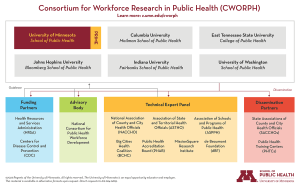CWORPH
The Consortium for WOrkforce Research in Public Health (CWORPH) is a public health workforce research consortium consisting of six universities:
- University of Minnesota (Jonathon P. Leider, PhD and Janette Dill, PhD, MA, MPH)
- Columbia University (Heather Krasna, PhD, MS, EdM)
- East Tennessee State University (Michael Meit, MA, MPH)
- Indiana University (Valerie Yeager, DrPH, MPhil)
- Johns Hopkins University (Beth Resnick, DrPH, MPH)
- University of Washington (Betty Bekemeier, PhD, MPH, MSN)
Each of our nationally-known consortium leaders brings decades of expertise specific to public health workforce in the United States, as well as the research capacity of a highly-ranked university, making CWORPH uniquely qualified to support and evaluate large-scale public health workforce development efforts. Our collaboration with national-level partners ensures that our work is grounded in real public health practice needs.
Together we also form the home of HRSA and CDC’s first federally funded Public Health Workforce Research Center (PHWRC).
View the Consortium for Workforce Research in Public Health website to learn more about the PHWRC and other projects.
Contact us to discuss your technical assistance needs: cphs@umn.edu

